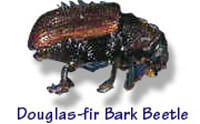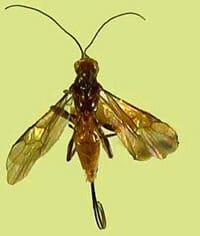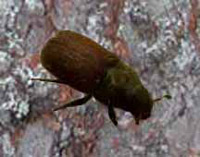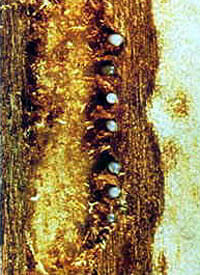Douglas Fir Bark Beetle – Coleoptera Scolytidae Dendroctonus pseudotsugae
 |
 |
 |
 |
 |
Identification & Description:
Adult beetles are dark brown to black with maroon-colored elytra, and are fairly large for members of the genus Dendroctonus (8mm or 1/3 in long). Parent galleries are formed between the bark and wood surface, and are straight and parallel to the grain of the tree. Eggs are laid in rows along alternating sides of the parent gallery. Larval galleries fan out from the parent gallery and end in the outer bark where the pupal and adult stages are formed. Boring dust in bark crevices and at the base of a tree are signs of attack. There are generally no pitch tubes present, although resin may exude from attacks in the upper bole.
Evidence that a Douglas-fir has been successfully attacked is the red-orange boring dust in bark crevices (fig. 01) or on the ground around the tree. Attacks are often high on the tree’s bole, so careful inspection may be required to determine if beetles are present. Sometimes the most evident sign of infestation is the clear resin exuded from entrance holes high on the stem near the upper limit of infestation (fig. 02). These “pitch streamers” are often visible from a considerable distance.
In the phloem, egg galleries are parallel to wood grain and are commonly 8 to 10 inches in length. Eggs are laid alternately along opposite sides of alleries (fig. 03). Larvae mine outward from the egg gallery and later eed toward the outer bark. Most broods overwinter as adults in the outer bark. The primary attack period is from mid-April to early June. Beetles that overwintered as larvae attack in midsummer. Adults are about one-fourth inch long, and are black with red-brown wing covers.
Effects:
Douglas-fir beetles normally breed in weakened or down hosts. In certain instances when down or weakened host material is particularly abundant, beetle populations can build to high levels and nearby standing hosts may be attacked and killed. Outbreaks are sporadic and usually of short duration, subsiding after two or three years. Since Douglas-fir beetles strongly prefer the largest trees in a stand, even short-duration outbreaks can have significant effects on stand structure and gap formation.
Ecological Role:
Douglas-fir beetles accelerate the rate of decomposition of down host material by introducing decay fungi and increasing access to the wood for other agents of deterioration. In the case of infestation of standing trees, Douglas-fir beetles help create gaps in the forest and cause changes in species composition and structure in stands containing large Douglas-firs. They often kill individual Douglas-firs weakened by other agents (dwarf mistletoe, root pathogens, drought).
Life History:
The Douglas-fir beetle has one generation per year. Adult flight usually takes place in the spring or early summer, whenever air temperatures exceed 15 C (60 F). Female beetles initiate attacks on suitable host material, attract other females and males to the tree with pheromones, and construct egg galleries beneath the bark. The eggs hatch within one to three weeks and young larvae typically feed in the phloem. Later, the larvae enter the outer bark where they construct pupal chambers. The winter is spent in the outer bark, either in the late larval, pupal, or adult stage. Those insects overwintering as adults will be the first to fly in the following spring, and may re-emerge, fly again, and establish a second brood in late June or July.
Conducive Habitats:
Douglas-fir beetles depend on weakened host material and will take advantage of trees debilitated by other agents. Any condition that weakens Douglas-firs will lead to increased habitat for Douglas-fir beetles. Outbreak populations require some form of large-scale disturbance before they develop.
Typically, major fires, large wind storms, or extensive amounts of tree breakage associated with especially heavy snow falls will lead to greatly elevated populations of Douglas-fir beetles because of the large amounts of preferred habitat that suddenly become available with such events. Beetle populations that build up in the downed or injured trees can then infest nearby green trees. Usually, these elevated populations can persist for two to three years in green hosts before subsiding once again to low levels
Management:
Direct control of Douglas-fir beetles is seldom warranted. As with other bark beetles, the key to limiting populations of Douglas-fir beetles is to provide good growing conditions for host trees. Because damaged hosts (fire kills, windthrown trees, broken trees, logging slash) are very important in the population dynamics of these beetles, it is important to salvage such material promptly if avoiding infestation of surrounding trees is a desired objective. In some cases, the anti-aggregating pheromone MCH has been used to prevent colonization of down material and thus limit population growth of Douglas-fir beetles. MCH has also been shown to be effective in preventing attacks to standing trees. This technique is usually used when small areas of high-value trees need protection